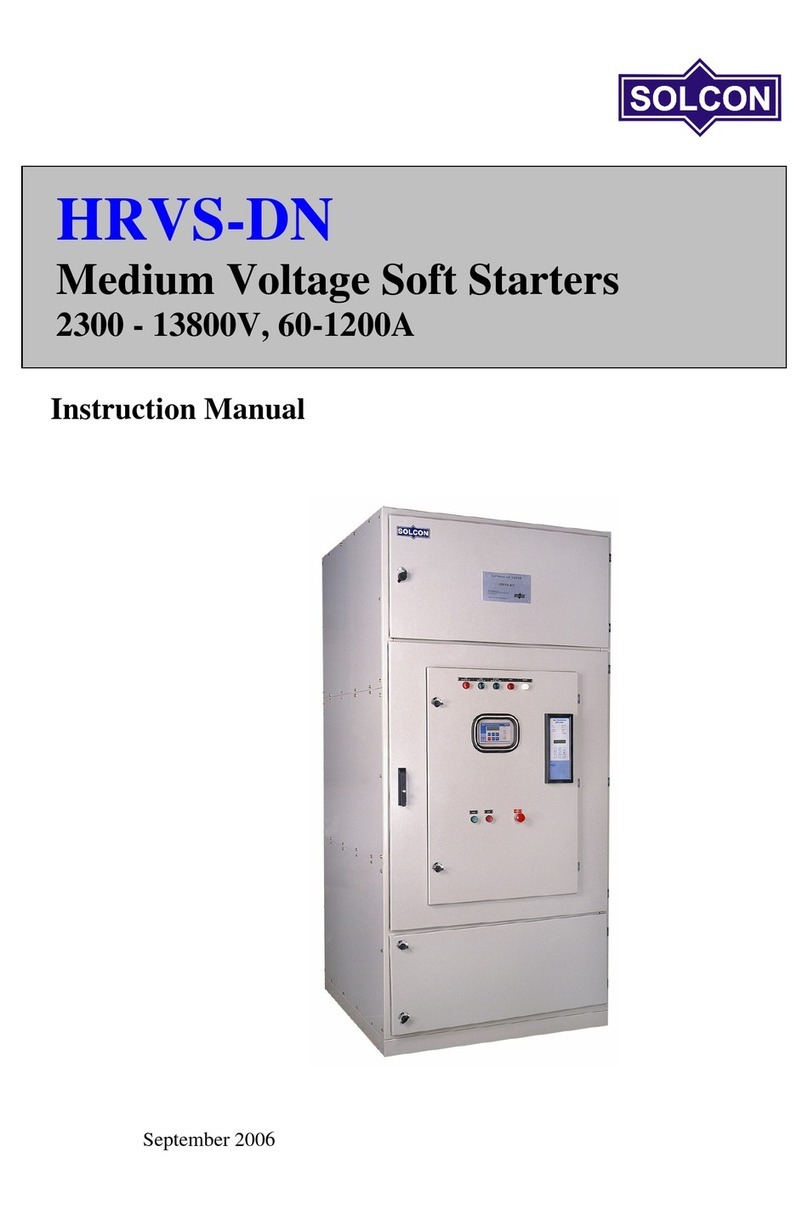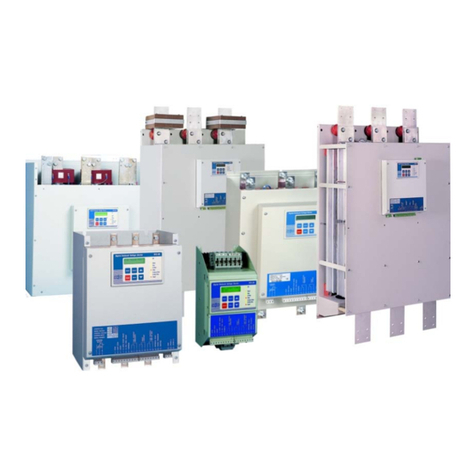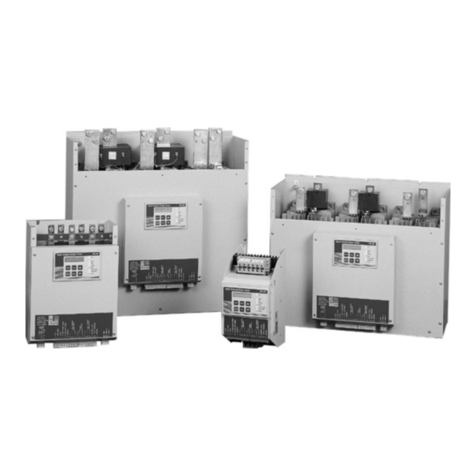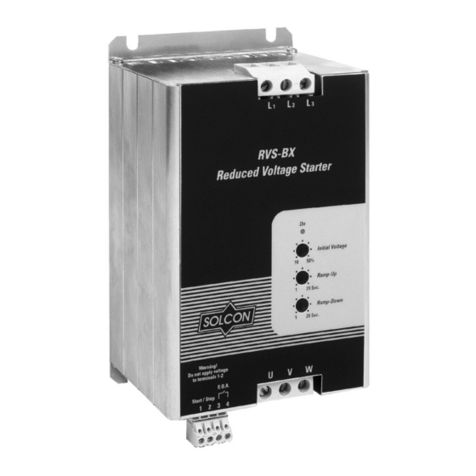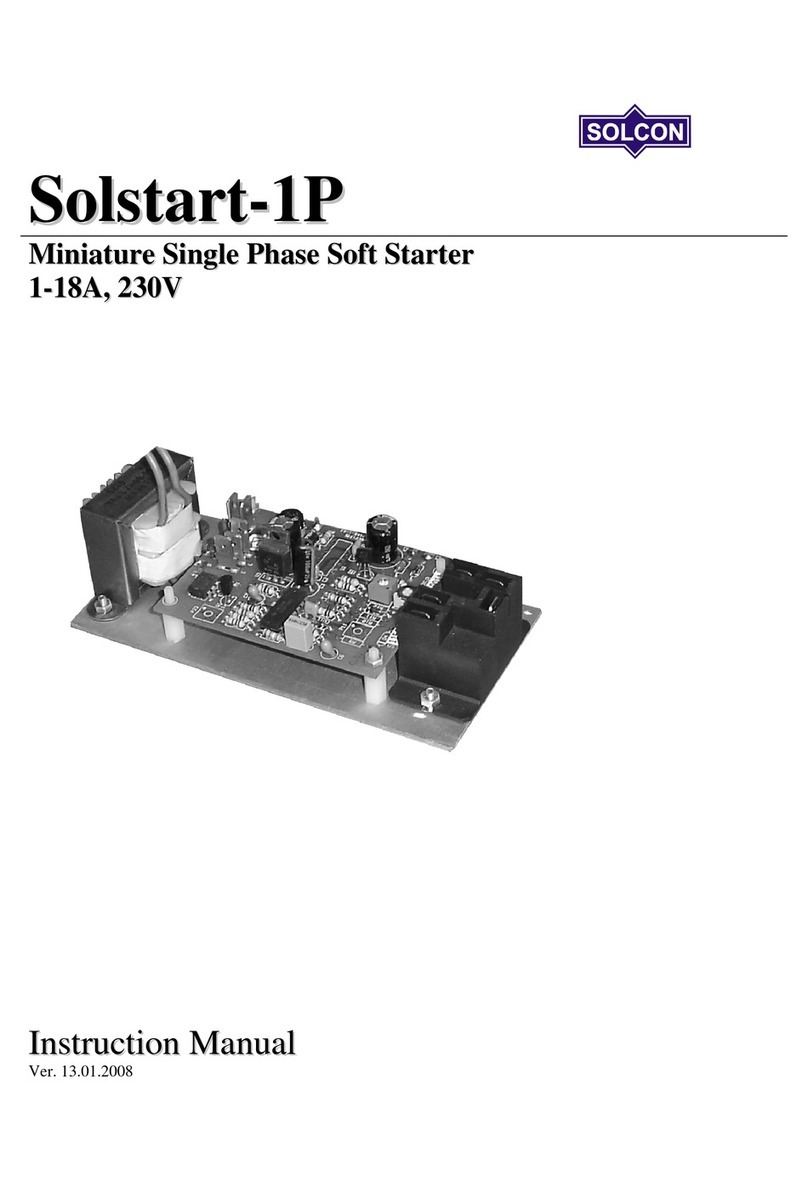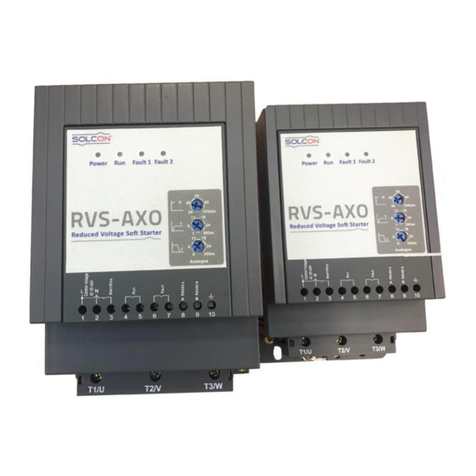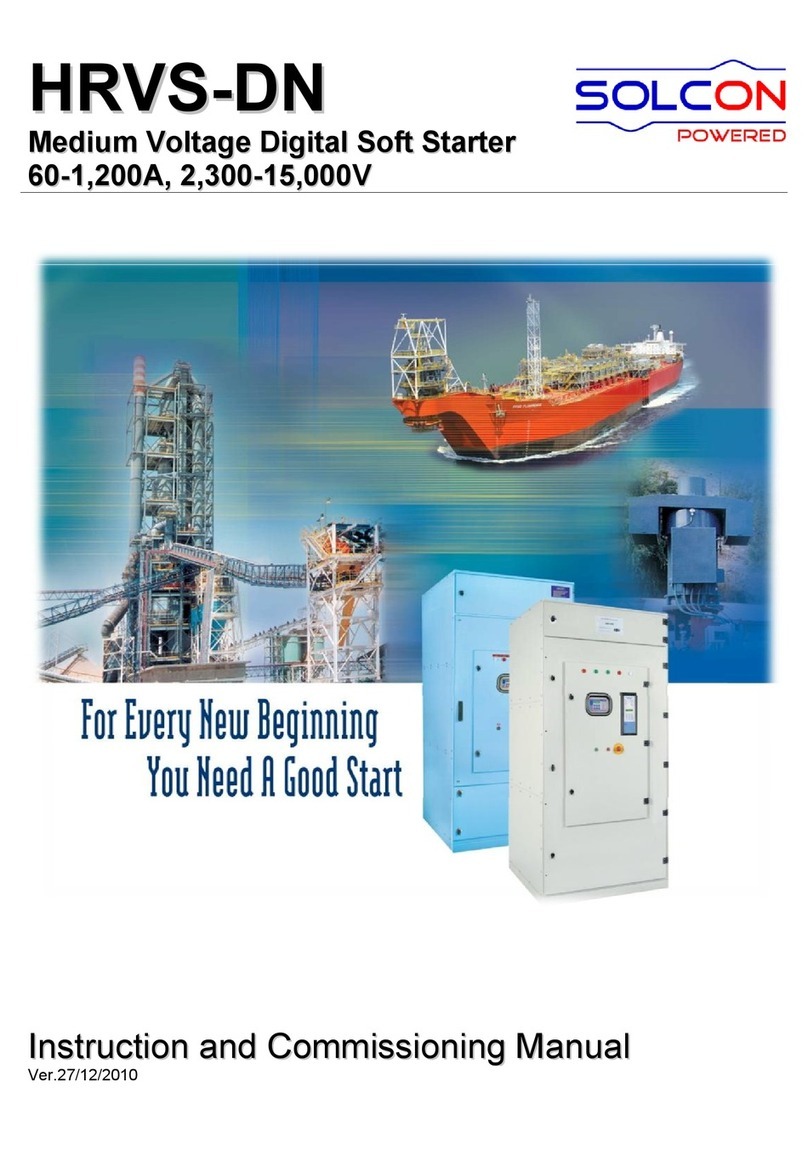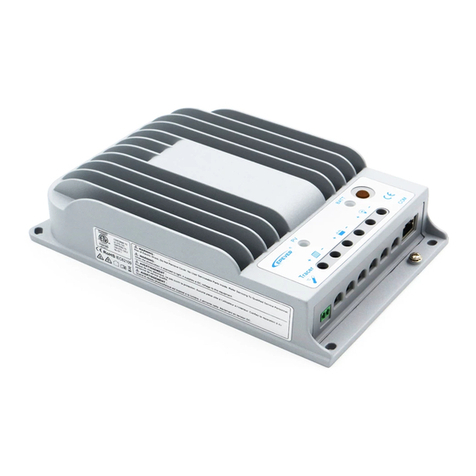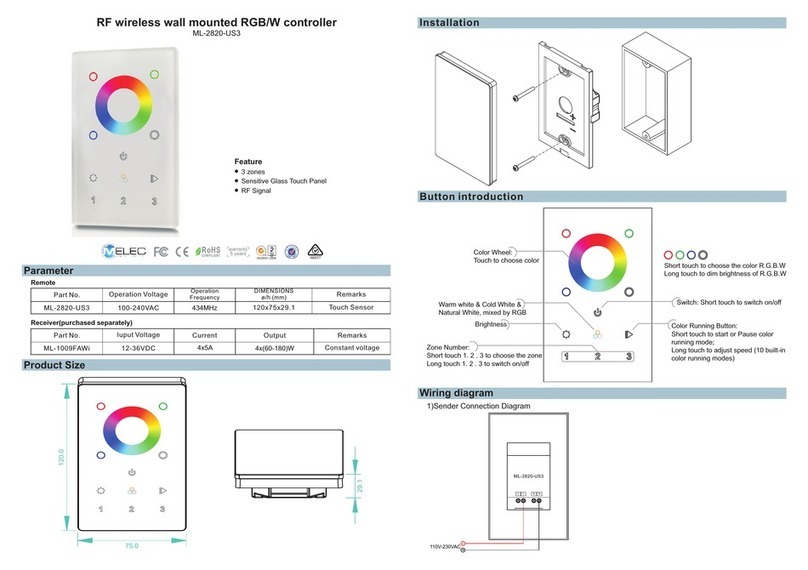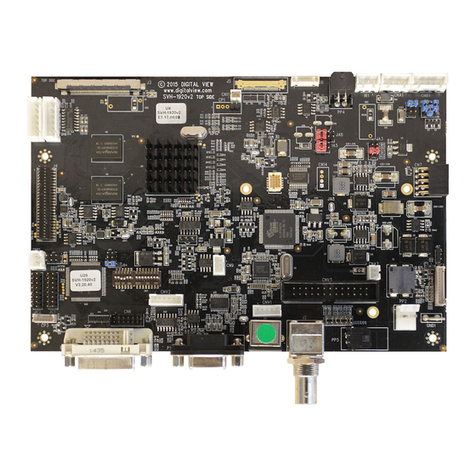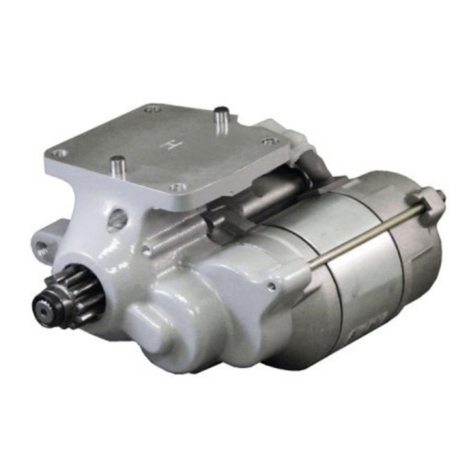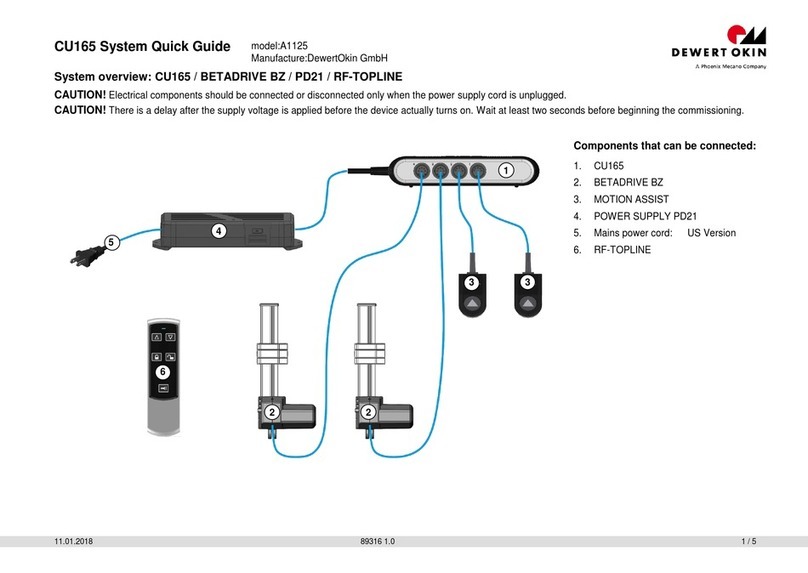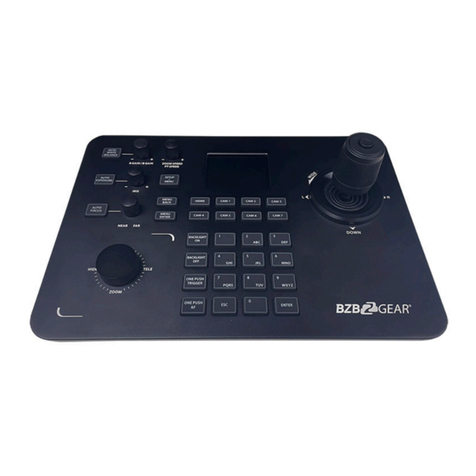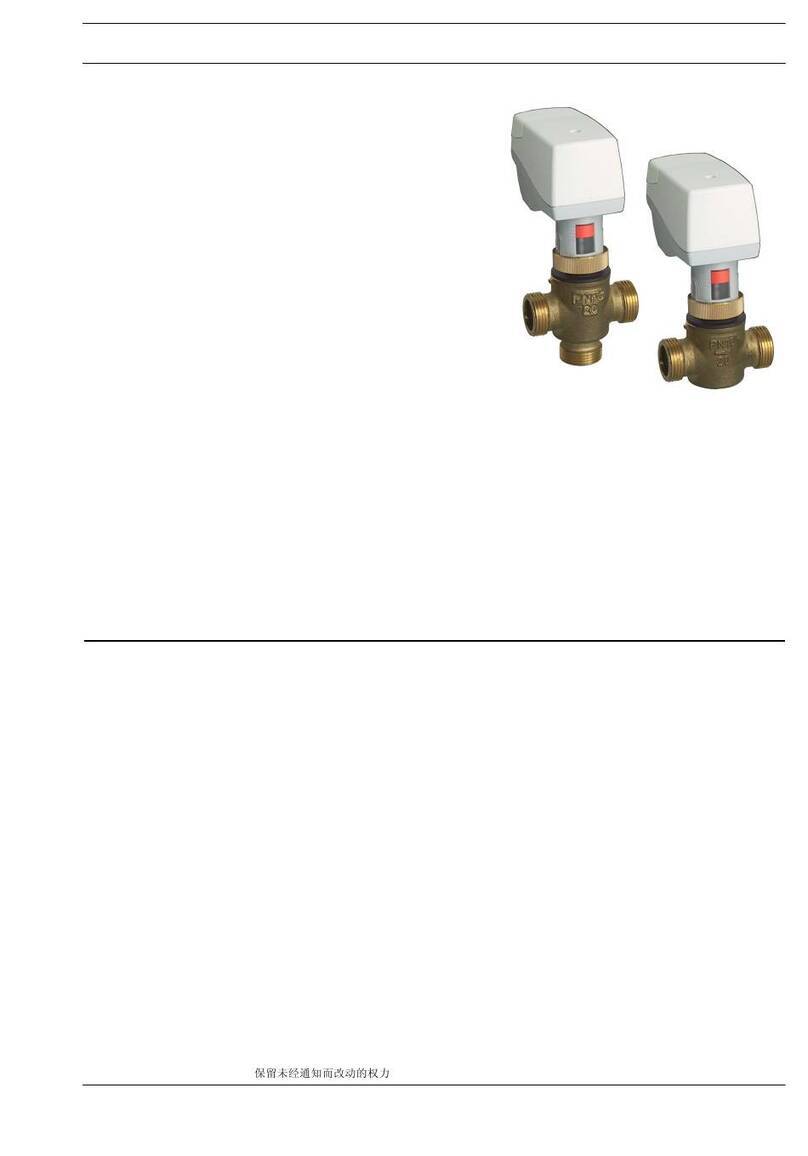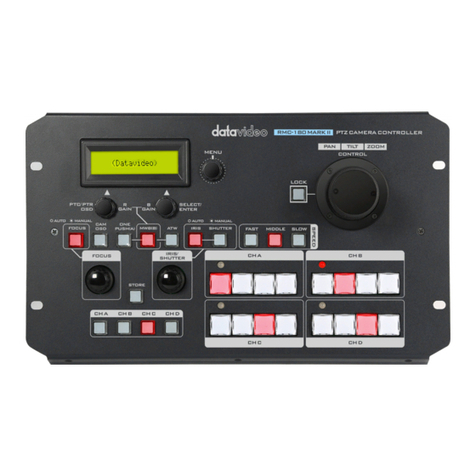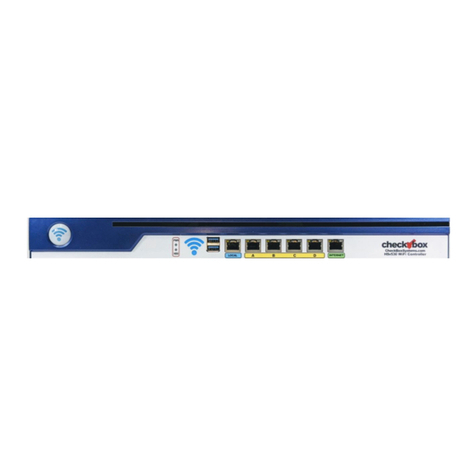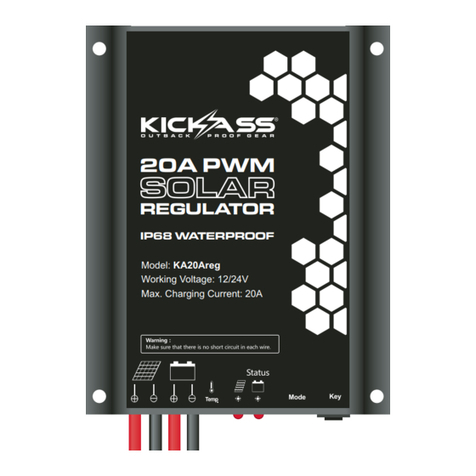Solcon RVS-DX Series User manual

R
RV
VS
S-
-D
DX
X
D
Di
ig
gi
it
ta
al
lS
So
of
ft
tS
St
ta
ar
rt
te
er
rw
wi
it
th
hi
in
nt
te
er
rn
na
al
lB
By
yP
Pa
as
ss
s
8
8-
-1
11
10
00
0A
A,
,2
22
20
0-
-6
69
90
0V
V
I
In
ns
st
tr
ru
uc
ct
ti
io
on
nM
Ma
an
nu
ua
al
l
1B
Ver. 26/12/2012

2• Table ofcontent
__________________________________________________________________________________
RVS-DX Instruction Manual
1. TABLE OF CONTENT
1. Table of content........................................................................................................................2
2. Safety & Warnings....................................................................................................................4
2.1 Safety..........................................................................................................................................4
2.2 Attention......................................................................................................................................4
2.3 Warnings.....................................................................................................................................4
3. Technical Data..........................................................................................................................5
3.1 Introduction.................................................................................................................................5
3.2 Rating and frames sizes.............................................................................................................5
3.3 Starter Selection.........................................................................................................................5
3.3.1 Motor current & Starting Conditions................................................................................5
3.3.2 Mains Voltage (line to line)..............................................................................................6
3.3.3 Control Voltage ...............................................................................................................6
3.3.4 Other Options..................................................................................................................6
3.3.5 Starter selection tables for various voltage ratings. ........................................................6
3.3.5.1 Starter selection for 230V, 400V, 480V, 600V .........................................................6
3.3.6 Ordering Information.......................................................................................................7
4. Recommended Wiring Scheme...............................................................................................8
4.1 Typical wiring diagram................................................................................................................8
4.2 Power wiring scheme for “Inside-Delta”Connection..................................................................9
4.3 Wiring Notes...............................................................................................................................9
4.3.1 Short Circuit Protection.................................................................................................10
4.3.2 Transient Protection......................................................................................................10
4.3.3 Control Supply (Terminals A1, A2)................................................................................10
4.3.4 Start/Stop (or 4.3.4momentary start) Input (terminal B1)..............................................10
4.3.5 Aux. Input (terminal C1)................................................................................................11
4.3.6 Auxiliary output relay (terminals 13, 14)........................................................................11
4.3.7 Fault Contact (terminals 23, 24)....................................................................................11
4.3.8 Options description .......................................................................................................11
4.3.8.1 Analogue I/O (option # 5) (terminals T1, T2, Gnd, Out (-), Out (+))......................11
4.3.8.2 RS-485 Communication (option # 3M) (terminals out(-),Out(+))...........................12
4.3.9 “Inside-Delta” mode.......................................................................................................12
4.3.9.1 General information................................................................................................12
4.3.9.2 Notes on “Inside Delta” connection........................................................................13
5. Dimensions.............................................................................................................................14
6. Installation...............................................................................................................................18
6.1 Prior to Installation....................................................................................................................18
6.2 Mounting...................................................................................................................................18
6.3 Temperature range & heat dissipation......................................................................................18
6.3.1 Calculating the enclosure size, for non-ventilated metallic enclosure...........................18
6.3.2 Additional Ventilation.....................................................................................................19
6.3.3 UL, cUL Installation Instructions....................................................................................19
7. Control Keypad.......................................................................................................................20
7.1 LCD Arrangement.....................................................................................................................20
7.2 Push-buttons.............................................................................................................................
20
7.3 Status LEDs..............................................................................................................................21
7.4 Reviewing and Modifying Parameters......................................................................................21
7.5 Special Actions Performed in TEST/MAINTENANCE Mode....................................................
21
7.5.1 Run Self Test ................................................................................................................21
7.5.2 View Software Version..................................................................................................21

3• Table ofcontent
__________________________________________________________________________________________
2551B7.5.3 Obtain Default Parameters............................................................................................22
2552B7.5.4 Reset Statistical Data....................................................................................................22
2553B7.5.5 Calibrate Voltage, Current and (Factory Use Only!) ...................................................23
2524B7.6 Mode Pages..............................................................................................................................23
2554B7.6.1 Overview of All Mode Pages and Factory Defaults.......................................................24
2555B7.6.2 Display Mode – page 0 .................................................................................................26
2556B7.6.3 Main Parameters – page 1............................................................................................27
2582B7.6.3.1 Tripping Curves of the Integrated Overload Protection..........................................30
2557B7.6.4 Start Parameters – page 2............................................................................................31
2583B7.6.4.1 Soft start parameters..............................................................................................34
2558B7.6.5 Stop Parameters – page 3............................................................................................35
2584B7.6.5.1 Soft stop parameters..............................................................................................35
2559B7.6.6 Dual Adjustment Parameters – page 4.........................................................................37
2560B7.6.7 Special features Parameters – page 5..........................................................................38
2585B7.6.7.1 WIDER SETTINGS Parameters:............................................................................39
2561B7.6.8 Fault Parameters – page 6............................................................................................40
2562B7.6.9 I/O Programming Parameters – page 7........................................................................42
2586B7.6.9.1 PROG. INPUT C1 ..................................................................................................43
2563B7.6.10 Comm. Parameters – page 8- Applicable with Optional Modbus & DeviceNet Comm. 44
2564B7.6.11 Comm. Parameters – page 8 - Applicable with Optional Profibus Comm.....................45
2565B7.6.12 Statistical Data – page 9...............................................................................................46
2525B7.7 Non adjustable protection anf fault Resetting...........................................................................46
2566B7.7.1 Phase loss (and Under / Over Frequency)....................................................................46
2567B7.7.2Phase Sequence...........................................................................................................47
2568B7.7.3 Shorted SCR or Wrong Connections............................................................................47
2569B7.7.4 Heat-sink Over Temperature.........................................................................................47
2570B7.7.5 External Fault................................................................................................................47
2571B7.7.6 Fault and Reset.............................................................................................................47
2572B7.7.7 Auto Reset ....................................................................................................................47
2526B7.8 Timing Occurrence Table .........................................................................................................48
2504B8. STARTING PROCEDURE .......................................................................................................49
2527B8.1 Setting control voltage on-site RVS-DX8A-310A......................................................................49
2528B8.2 Standard starting procedure.....................................................................................................50
2529B8.3 Examples of starting curves......................................................................................................51
2573B8.3.1 Light Loads-Pumps, Fans, etc. .....................................................................................51
2574B8.3.2 High Inertia Loads – Fans, Centrifuges, etc..................................................................51
2575B8.3.3 Special starting – Using Dual Adjustment.....................................................................52
2587B8.3.3.1 Special starting – Using Dual Adjustment – wiring scheme...................................53
2576B8.3.4 Choosing a suitable Pump Curve (centrifugal Pumps) .................................................53
2588B8.3.4.1 Starting Curve........................................................................................................53
2589B8.3.4.2 Stopping Curve ......................................................................................................54
2590B8.3.4.3 Final torque during soft-stopping a pump motor ....................................................54
2505B9. TROUBLE SHOOTING............................................................................................................55
2530B9.1 Blank RMA Form ......................................................................................................................58
2506B10. TECHNICAL SPECIFICATIONS: ............................................................................................59

4•Safety & Warnings
__________________________________________________________________________________
2. SAFETY & WARNINGS
2.1 Safety
1
Read this manual carefully before operating the equipment and follow its
instructions.
2Installation, operation and maintenance should be in strict accordance
with this manual, national codes and good practice.
3
Installation or operation not performed in strict accordance with these
instructions will void manufacturer’s warranty.
4
Disconnect all power inputs before servicing the soft-starter and/or the
motor.
5
After installation, check and verify that no parts (bolts, washers, etc) have
fallen into the starter.
6
During shipping, the soft-starter might have been roughly handled,
therefore, it is recommended to initialize the soft-starter by connecting
supply voltage prior to operating the soft-starter with a motor
2.2 Attention
1
This product was designed for compliance with IEC 947-4-2 for class A
equipment.
2
RVS-DX 8 -170 are UL and cUL approved. RVS-DX 210 -1100 are
designed to meet UL and cUL requirements.
3
Use of the product in domestic environments may cause radio
interference, in which case, the user may be required to employ
additional mitigation methods.
4Utilization category is AC-53a or AC53b, Form 1. For further information,
see Technical Specification
2.3 Warnings
1
Internal components and PCBs are at mains potential when the RVS-DX
is connected to mains. This voltage is extremely dangerous and will
cause death or severe injury if contacted.
2
When RVS-DX is connected to mains, even if control voltage is
disconnected and motor is stopped, full voltage may appear on starter’s
output and motor’s terminals.
3
The starter must be grounded to ensure correct operation, safety and to
prevent damage.
4
Check that Power Factor capacitors and overvoltage devices are not
connected to the output side of the soft starter.
If PF capacitors are used, they must be connected on the line side of the
RVS-DX .
If a main contactor is used in combination with RVS-DX, the capacitors
must be disconnected from RVS-DX when contactor is open.
5
Do not interchange line and load connections
The company reserves the right to make any improvements or modifications to its products without
prior notice.

5• Technical Data
___________________________________________________________________________________________
3. TECHNICAL DATA
3.1 Introduction
The RVS-DX is a third generation, highly sophisticated and reliable starter designed for use with
standard three-phase, three-wire, squirrel cage, induction motors.
It provides the best method of reducing current and torque during motor starting.
The RVS-DX starts the motor by supplying a slowly increasing voltage, providing soft start and smooth
acceleration, while drawing the minimum current necessary to start the motor.
The RVS-DX is equipped with internal by-pass controlled by its micro-controller. The by-pass closes
after the end of the starting process, thus reducing heating and saving power.
3.2 Rating and frames sizes
Starter type
Starter
FLC
[A]
Frame
Size
Dimensions
WxHxD
[mm]
Weight
[Kg]
RVS-DX 8
8
D1
120x232x122
3.0
RVS-DX 17
17
D1
120x232x122
3.0
RVS-DX 31
31
D1
120x232x122
3.0
RVS-DX 44
44
D1
120x232x122
3.0
RVS-DX 58
58
D2
129x275x182
5.2
RVS-DX 72
72
D2
129x275x182
5.2
RVS-DX 85
85
D3
129x380x182
8.5
RVS-DX 105
105
D3
129x380x182
8.5
RVS-DX 145
145
D4
172x380x192
12.5
RVS-DX 170
170
D4
172x380x192
12.5
RVS-DX 210
210
D5
380x455x295
30.2
RVS-DX 310
310
D5
380x455x295
30.2
RVS-DX 390
390
D6
350x550x310
55
RVS-DX 460
460
D7
460x600x319
65
RVS-DX 580
580
D8
460x643x319
75
RVS-DX 650
650
D8
460x643x318
80
RVS-DX 820
820
D8
460x643x318
90
RVS-DX 950
950
D9
560x833x334
100
RVS-DX 1100
1100
D9
560x833x334
100
3.3 Starter Selection
The starter should be selected in accordance with the following criteria:
3.3.1 Motor current & Starting Conditions
Select the starter according to motor's Full Load Ampere (FLA) - as indicated on its nameplate (even if
the motor will not be fully loaded).
The RVS-DX is designed to operate under the following maximum conditions:
Ambient
Temperature
[
0
C]
Starting Current
[A]
Acceleration Time
[sec]
40
300%xIn
30
350%xIn
20
400%xIn
5
Max. Starts per Hour: four (4) starts per hour at maximum ratings and up to 10 starts per hour at light
load
applications (consult factory).
Note:
For very frequent starts (inching applications) the inching current should be considered as the Full Load
Current (FLC) (consult factory).
Notes:
Refer to section
5 on page 14 for detailed dimensions.

6• Technical Data
________________________________________________________________________________________
3.3.2 Mains Voltage (line to line)
Four Main Voltage levels are available: 400V, 480V, 600V and 690V (690V only available for RVS-DX
390A and up).
Note:
400V applies for 230 to 400V.
3.3.3 Control Voltage
The Control Voltage (terminals A1(~) – A2 (N) operates the electronic circuitry and the bypass.
Two voltage levels are available, selectable by internal jumper:
230VAC + 10%-15%, 50/60 Hz (standard)
115VAC+ 10%-15%, 50/60 Hz
Refer to section 8.1 on page 49 for instructions on setting control voltages on site.
3.3.4 Other Options
More options are available for the RVS-DX. (Refer to section 3.3.6 on page 7.):
Communication, Analog card, harsh environment treatment, , Remote panel,UL & cUL approval .
3.3.5 Starter selection tables for various voltage ratings.
1
The starter selection table below concern standard, 1500r.p.m. 50Hz,
three-phase motors.
2
These values are given for guidance and may vary according to motor
manufacturer and depending on the number of poles.
3
It is the user’s responsibility to make sure that motor’s FLA will never
exceed Starter’s FLC.
3.3.5.1 Starter selection for 230V, 400V, 480V, 600V
Note:
C – Consult factory
Starter type
Starter
FLC
[A]
Motor
kW
@230V,
starter
“In-Line”
[kW]
Motor
kW
@230V,
starter
“Inside
Delta”
[kW]
Motor
kW
@400V,
starter
“In-Line”
[kW]
Motor
kW
@400V,
starter
“Inside
Delta”
[kW]
Motor
kW
@480V,
starter
“In-Line”
[kW]
Motor
kW
@480V,
starter
“Inside
Delta”
[kW]
Motor
kW
@600V,
starter
“In-Line”
[kW]
Motor
kW
@600V,
starter
“Inside
Delta”
[kW]
RVS-DX 8
8
1.5
3
3
6.5
4
8
5.5
9
RVS-DX 17
17
4
8
8
12.5
9
15
12.5
22
RVS-DX 31
31
8
15
15
25
18.5
30
25
40
RVS-DX 44
44
12.5
22
22
37
25
45
30
59
RVS-DX 58
58
15
30
25
51
37
59
45
80
RVS-DX 72
72
20
37
37
59
45
80
59
100
RVS-DX 85
85
25
40
45
80
55
90
59
110
RVS-DX 105
105
30
55
55
90
59
110
80
147
RVS-DX 145
145
40
75
75
132
90
160
110
200
RVS-DX 170
170
51
90
90
160
110
200
140
250
RVS-DX 210
210
59
110
110
184
140
220
160
295
RVS-DX 310
310
90
160
160
257
200
355
257
450
RVS-DX 390
390
110
200
200
355
257
475
315
560
RVS-DX 460
460
140
220
250
400
295
560
400
670
RVS-DX 580
580
180
315
315
560
400
670
500
RVS-DX 650
650
c
c
c
c
c
c
c
c
RVS-DX 820
820
250
450
450
670
560
670
RVS-DX 950
950
295
500
500
670
-
RVS-DX 1100
1100
355
560
600
-

7• Technical Data
___________________________________________________________________________________________
3.3.6 Ordering Information
RVS-DX
31-
400-
230-
0-
S
Full load
Current
Mains Voltage
Control
Voltage
Options
Front Panel
Full load Current
Specify
Description
Starter’s
FLC [A]
8, 17, 31, 44, 58, 72, 85, 105, 145, 170, 210, 310, 390, 460, 580, 650, 820, 950, 1100
Mains Voltage
Specify
Description
400
230-400VAC + 10%-15%, 50/60 Hz
480
480VAC + 10%-15%, 50/60 Hz
600
600VAC + 10%-15%, 50/60 Hz
690
690VAC + 10%-15%, 50/60 Hz (690V only available for RVS-DX 390A and up)
Control Voltage
Specify
Description
115
115VAC + 10%-15%, 50/60 Hz
230
230VAC + 10%-15%, 50/60 Hz
Note:
•Control voltage can be changed on site for RVS-DX up to 310A.
•For RVS-DX 390A and up control voltage must be ordered from factory.
Options
Specify
Description
0
No options
3M
Communication RS-485 (MODBUS) (1)
3P
Communication Profibus PCB (RVS-DX210-1100A)(2)
3D
Communication RS-485 (MODBUS) and external DevieNet to Modbus Gateway(1) (4)
5
Analog card – Thermistor in and Analog out (1) (2)
8
Harsh environment treatment
D
Remote panel mounting replacing the original panel.( supplied with 1.5 m cable)(3)
U
UL & cUL approval (RVS-DX8-170A mains voltage up to 600V)
Notes:
•For more than one option indicate, for example: 8+5 (Harsh environment and
analog out)
•Options must be factory installed.
•(1) From RVSDX-8A and up to RVS-DX44A - One option can be installed -
either Modbus communication (3M) or analog (5).
From RVS-DX58A and up - both options 3M & 5 can be installed. Both
options must be ordered as one package.
•(2) From RVS-DX210A and up - both options 3P & 5 can be installed. Both
options must be ordered as one package.
•(3) Remote keypad option available for RVS-DX 58A and up.
•Mains voltage of 690V only available for RVS-DX 390A and up.
•(4) External DeviceNet to Modbus Gateway is supplied when DeviceNet
communication link is ordered.
Front Panel
Specify
Description
S
Standard
Example:
RVS-DX rated 820A, mains voltage- 230V, control voltage- 115V, Modbus communication card, Analog
card, Harsh environment treatment and standard front panel:
RVS-DX 820 - 400 - 115 - 3M+5+8 – S

8• Recommended Wiring Scheme
________________________________________________________________________________________
4. RECOMMENDED WIRING SCHEME
4.1 Typical wiring diagram
Notes:
(1) - Use fuses for type 2 coordination. Refer to section 4.3.1 on page 10
(2) - For Aux. input programming refer to section 7.6.9 on page 42
The use of solid state relays to control the digital inputs B1 and C1 is prohibited
(3) - For Aux. output programming refer to section 7.6.9 on page 42
(4) - Fault relay can function as a “Fault” relay or as a “Fail-Safe” relay. For Fault relay
programming refer to section 7.6.9 on page 42
(5) - When emergency Stop switch is required it is recommended to trip a series contactor
or the feeding circuit breaker. (Not shown)
(6) – Mains voltage of 230-600V available to all models. (need to be specified)
Mains voltage of 690V only available for RVS-DX390A and up.

9• Recommended Wiring Scheme
___________________________________________________________________________________________
4.2 Power wiring scheme for “Inside-Delta” Connection
(Refer to section 4.3.9 on page 12)
Connecting RVS-DX INSIDE DELTA
Reverse speed with RVS-DX connected INSIDE DELTA.
Notes:
When installing the RVS-DX INSIDE DELTA. it is highly recommended to
use a line contactor (C1) or INSIDE DELTA. contactor (C2) in order to avoid
a destruction of the motor in case of a shorted SCR in the RVS-DX.
If a contactor is connected Inside the Delta (C2) only, motor terminals are
“live” (full voltage) even when contactor is open.
4.3 88BWiring Notes
WARNINGS!
When mains voltage is connected to the RVS-DX, even if control voltage is
disconnected, full voltage may appear on the starter load terminals.
Therefore, for isolation purposes, it is necessary to connect an isolating device
before the starter.

10 • Recommended Wiring Scheme
________________________________________________________________________________________
Power factor correction capacitors and overvoltage devices must not be
installed on starters load side. When required, install capacitors or overvoltage
devices on starter’s line side.
4.3.1 Short Circuit Protection
For “class 2 coordination”, protect the starter against a short circuit by thyristor Protection Fuses for I²t
and fuses as in dictated in the following table:
Notes:
1. The above table is for maximum starting current of 400% of FLC, maximum starting time
of 5 sec and rated voltage up to 690V V.
2. Rating may change with different external conditions such as ambient temperature, forced
cooling etc. Refer to fuse manufacturer catalogs to confirm correct values.
4.3.2 Transient Protection
Line transient voltages can cause a malfunction of the starter and damage to the thyristors. All RVS-DX
starters incorporate Metal Oxide Varistors (MOV) to protect from normal line voltage spikes.
When higher transients are expected, additional external protection should be used (consult factory).
4.3.3 Control Supply (Terminals A1, A2)
220-240V or 110-120V, 50/60Hz is required to power the electronic circuitry and the bypass. Factory set
value is indicated on the starter’s side label.
This voltage can be from a grounded or ungrounded mains system.
In models up to 310A, voltage level 110V /220V can be changed in the field. (Refer to section 8.1 on
page 49)
4.3.4 Start/Stop (or 4.3.4momentary start) Input (terminal B1)
Input from a maintained contact. Close contact between A2 and B1 to soft start the motor.
To stop the motor open the contact.
If Deceleration time is set to a value other then 0 seconds the motor will soft stop.
If Deceleration time is set to 0 seconds the motor will stop immediately. (Refer to section 7.6.5 on page
35)
If Aux Input is set as Start / Stop, then terminal B1 is used as momentary N.O. Start input and input C1 is
used as maintained N.C Stop input. (Refer to section 7.6.9 on page 42)
For emergency stop of the motor disconnect control voltage from A1, A2 terminals.
RVS-DX
Max.
thyristor
I
2
t [A
2
Sec]
BUSSMAN GEC ALSTOM SIBA FERRAZ – SHAWMUT
(IEC Style 690/700V)
Rate
[A]
P/N
Rate
[A]
P/N
Rate
[A]
P/N
Rate
[A]
P/N
RVS – DX 8
400
30
FWP 30B
32
B210612
32
URD 000-32
RVS – DX 17
5,000
50
FWP 50B
63
B210615
63
6.6URD30D11A0063
RVS – DX 31
10,000
90
FWP 90B
100
V320063
100
6.6URD30D11A0100
RVS – DX 44
12,000
125
FWP 125A
100
X320063
100
6.6URD30D11A0100
RVS – DX 58
15,000
150
FWP 150A
125
X320065
125
6.6URD30D11A0125
RVS – DX 72
18,000
175
FWP 175A
160
B320069
200
SQB1-200
200
6.6URD30D11A0200
RVS – DX 85
40,000
200
FWP 200A
200
E320371
200
SQB1-200
200
6.6URD30D11A0200
RVS – DX 105
60,000
250
FWP 250A.
250
J320375
250
SQB1-250
250
6.6URD30D11A0250
RVS – DX 145
100,000
300
FWP 300A
315
M320079
315
SQB1-315
315
6.6URD30D11A0315
RVS – DX 170
140,000
400
FWP 400A
350
Y320480
350
SQB1-350
350
6.6URD30D11A0350
RVS – DX 210
200,000
500
FWP 500A
450
D320485
450
SQB1-450
450
6.6URD30D11A0450
RVS – DX 310
600,000
700
FWP 700A
630
H320489
630
SQB1-630
630
6.6URD31D11A0630
RVS – DX 390
700,000
700
FWP 700A
800
T320591
800
SQB1-800
800
6.6URD31D11A0800
RVS – DX 460
800,000
800
FWP 800A
900
V320592
900
SQB1-900
900
6.6URD32D11A0900
RVS – DX 580
1,200,000
1000
FWP 1000A
1000
W320593
900
SQB2-900
1000
6.6URD32D11A1000
RVS – DX 650 2,000,000 1200 FWP 1200A
2X
700
2X
S320590
1100 SQB2-1100 1250
6.6URD33D11A1250
RVS – DX 820 2,000,000 1200 FWP 1200A
2X
700
2X
S320590
1100 SQB2-1100 1250
6.6URD33D11A1250
RVS – DX 950 4,500,000
2X
1000
2X
FWP 1000A
2X
900A
2X
V320592
SQB2-1250 1600
6.6URD33D11A1600
RVS – DX 1100 4,500,000
2X
1000
2X
FWP 1000A
2X
900A
2X
V320592
SQB2-1250 1600
6.6URD33D11A1600

11 • Recommended Wiring Scheme
___________________________________________________________________________________________
4.3.5 Aux. Input (terminal C1)
Input from a maintained contact, connected between terminals A2 and C1 to operate as programmed
input.
Aux. Input can be programmed as one of six options:
(1) Dual Adjust
(2) Generator Function
(3) Slow Speed / Reverse
(4) External fault
(5) Remote reset after fault has been removed.
(6) Start / Stop (terminal C1 can be used as a maintained N.C Stop input and terminal B1 as
momentary N.O. Start input – refer also to section 4.3.4 above.
For Aux. Input programming refer to section 7.6.9 on page 42.
4.3.6 Auxiliary output relay (terminals 13, 14)
Voltage free, N.O , 8A, 250VAC, 1800VA max.
The contact incorporates 0-60 seconds On & Off delays. The auxiliary output relay can be programmed
to operate in two modes:
1. IMMEDIATE - Close its contact at start signal (after programmed “on delay” time has elapsed)
and open its contact at the end of deceleration time (if any) (after programmed “off delay” time has
elapsed).
2. END OF ACCEL. -Close its contact at end of soft start (after programmed “on delay” time has
elapsed) and open its contact at the beginning of soft stop (if any) (after programmed “off delay” time has
elapsed).
The relay contact will open also in case of a fault or upon control supply outage.
This output is generally used to:
(1) Release the brake of a brake motor.
(2) Interlocking with other systems.
(3) Signalling.
For Aux. output programming refer to section 7.6.9 on page 42.
4.3.7 Fault Contact (terminals 23, 24)
Voltage free, N.O , 8A, 250VAC, 1800VA max.
The contact changes its position upon fault and returns to its original position after fault has been
removed and starter was reset. When disconnection of Control Supply the contacts will be closed.
Fault relay can function as a “Fault” relay or as a “Fail-Safe” relay.
For Fault relay programming refer to section 7.6.9 on page 42.
4.3.8 Options description
4.3.8.1 Analogue I/O (option # 5) (terminals T1, T2, Gnd, Out (-), Out (+))
The Analogue option incorporates two functions:
•Thermistor input
•Analogue output
Analogue P.C.B. layout
Thermistor input (terminals T1, T2)
Programmable as PTC or NTC type thermistor. Trip value is adjustable between 1-10K, preset delay of 2
Sec.

12 • Recommended Wiring Scheme
________________________________________________________________________________________
For thermistor input programming refer to section 7.6.8 on page 40.
Ground Terminal (terminal Gnd)
Connect thermistor and / or Analogue output shield to this ground terminal.
Analogue Output ( terminals Out (+), Out (-))
Dip switches allow selection between: 0-10VDC, 0-20mA, 4-20mA
Analogue value can be programmed via the key pad in I/O PROGRAMMING PARAMETERS page to
one of the values as follows: (refer to section 7.6.9 on page 42.)
A. 0….200% of FLA (Default setting)
B. 0….200% of Pn
C. Power factor (POWER FACTOR & POWER measurement only available in RVS-DX58A and up)
Dip No.
4-20 mA*
0-20 mA
0-10VDC
Dip-Sw. S1 # 1
On
On
Off
Dip-Sw. S1 # 2
On
On
Off
Dip-Sw. S1 # 3
Off
Off
On
Dip-Sw. S1 # 4
Off
Off
On
Dip-Sw. S2 # 1
On
Off
Off
Dip-Sw. S2 # 2
No use
No use
No use
* Default
Notes:
•It is important that the RVS-DX is properly grounded, and control module is tightly fastened to the
power section.
•Use twisted shielded cable for thermistor connection.
4.3.8.2 RS-485 Communication (option # 3M) (terminals out(-),Out(+))
Standard RS485, Half Duplex with MODBUS Protocol, baud rate 1200, 2400, 4800, 9600 BPS.
Twisted shielded pair should be used, connect shield to ground a PLC/Computer side.Terminals (-) & (+)
must be wired to control supply for operation in communication mode. Leave terminal NC not connected.
Note: When DeviceNet option is required an external device will be provided with the option.
This gateway is connected via 2 wires to the optional Modbus terminals.
Refer to section 7.6.10 on page 44.
4.3.9 “Inside-Delta” mode
4.3.9.1 General information
When the RVS-DX is installed “Inside Delta”, the individual phases of the Starter are connected in series
with the individual motor windings (6 conductor connections as with the star-delta starter). The soft
starter must only conduct about 67 % (=1\1.5) of the rated motor current. This ensures the use of a
significantly smaller device.
For example:
For a motor with a rated current of 155A motor, a 170A starter will be selected to operate “In-Line”.
For “Inside Delta” starter, we calculate (155 x 67% = 104A) and select a 105A starter.
Less heat dissipates in the cabinet vs. the standard “In-Line” connection.

13 • Recommended Wiring Scheme
___________________________________________________________________________________________
4.3.9.2 Notes on “Inside Delta” connection
•“Inside Delta” requires 6-wire to the motor.
•Wrong motor connection will cause serious damage to the motor windings.
•When installing the RVS-DX “inside delta” it is highly recommended to use a contactor in
series to the RVS-DX or upstream (after motor protection) in order to avoid a destruction
of the motor in case of a shorted SCR in the RVS-DX.
•The sinusoidal shape of the current is imperfect (since each phase is separately fired and
not influenced by other phase firing).
As a result, higher harmonic content is incurred (THD), which can be as high as twice the
THD value as in the standard “In-Line”.
•Higher motor heating is expected for the same motor size (due to the higher THD).
•Phase sequence must be correct; otherwise, “Phase Sequence fault” will trip the starter
immediately (without any damage).
•Higher torques can not be obtained
•Factory preset - features and functions when “Inside Delta” mode is configured:
oNo Pulse Start.
oNo curve selection (Curve 0 !! only).
oNo Slow Speed
oNo Phase sequence “Off” mode
Note :
For a high starting torque process, it is recommended to use the starter in the “In Line” connection.
WARNINGS!
Beware!
Wrong connection of the starter or the Motor, will seriously damage the motor.
When using “Inside delta” connection:
1. It is highly recommended to use a contactor in series to the RVS-DX
or upstream (after motor protection) in order to avoid a destruction of the
motor in case of a shorted SCR in the RVS-DX.
2. If Contactor is connected Inside the Delta, motor terminals are “live” (full
voltage) even when contactor is open.
RVS-DX connected INSIDE DELTA
Speed reverse with RVS-DX connected INSIDE
DELTA
(1) C1 is a line contactor.
(2) C2 is an “Inside Delta” contactor.
(3) U1-U2, V1-V2, W1-W2 are motor’s windings.
(4) L1-U, L2-V, L3-W are RVS-DX controlled phases.
Refer also to section 4.2 page 9.

14 • Dimensions
________________________________________________________________________________________
5. DIMENSIONS
RVS-DX 8, 17, 31, 44
Note:
Mains voltage terminals: 16mm2
RVS-DX 58, 72
RVS-DX 85, 105
RVS-DX 145, 170
RVS-DX 210

15 • Dimensions
___________________________________________________________________________________________
RVS-DX 310
RVS-DX 390

16 • Dimensions
________________________________________________________________________________________
RVS-DX 460
RVS-DX 580

17 • Dimensions
___________________________________________________________________________________________
RVS-DX 650-820
RVS-DX 950-1100

18 • Insta llation
________________________________________________________________________________________
Area (m2) =
6. INSTALLATION
WARNING!
Do not interchange line and load connections
6.1 89BPrior to Installation
Check that Motor’s Full Load Ampere (FLA) is lower than, or equal, to the starter’s Full Load Current
(FLC) and that Mains and Control voltages are as indicated on the starter’s side label.
Make sure Starter’s FLC≥ Motor FLA!
Make sure Mains voltage is right!
Make sure Control voltage is right!
RVS-DX label - example
6.2 90BMounting
The starter must be mounted vertically. Allow sufficient space (at least 100mm) above and below the
starter for suitable airflow.
It is recommended to mount the starter directly on the rear metal plate for better heat dissipation.
Note:
Do not mount the RVS-DX directly on the rear metal plate in case a ventilation fan or ventilation opening
is on the back side of the RVS-DX.
Do not mount the starter near heat sources.
Surrounding air temperature in the cabinet should not exceed 40ºC
Protect the starter from dust and corrosive atmospheres.
Note: For harsh environments (sewage treatment plants, etc.), it is recommended to order the starter
with printed circuit board coating. Refer to section 3.3.6 on page 7 for ordering information.
6.3 91BTemperature range & heat dissipation
The starter is rated to operate over a temperature range of -10ºC (14ºF) to + 40ºC (104ºF).
Relative non-condensed humidity inside the enclosure should not exceed 95%.
ATTENTION!
Operating at surrounding air temp. (Inside the cabinet) higher than 40ºC may
cause damage to the starter.
Starter’s heat dissipation while motor is running and the internal bypass relays are closed is typically less
than 0.4 x In (in watts). During soft start and soft stop, heating is approximately three times the actual
starting current (In watts).
Example: For a 100A motor, heat dissipation is less than 40 watts while running and during starting (for
example at 350A), heat dissipation is approximately 1050 watts.
Important note: If motor is frequently started, cabinet should be designed for the higher heat dissipation.
Internal enclosure heating can be reduced through the use of additional ventilation.
6.3.1 119BCalculating the enclosure size, for non-ventilated metallic enclosure
Where: Area [m2]]- Surface area that can dissipate heat (front, sides, top).
0.12 x Total heat dissipation [Watts]
60 – External ambient temp. [ºC]

19 • Insta llation
___________________________________________________________________________________________
Total heat dissipation [Watt] – The total heat dissipation of the starter and other control devices
in the enclosure. If starter is frequently started, average power should be used.
6.3.2 Additional Ventilation
Use the following arrangement for forced ventilation of the RVS-DX’s enclosure:
6.3.3 UL, cUL Installation Instructions
Input power and output motor field wiring shall be copper conductors, rated 75ºC.
Use UL listed closed-loop connectors sized for the selected wire gauge.
Install connectors using the correct crimp tool recommended by the connector
manufacturer. Applies only to units bus bars.
Table showing corresponding wire size, terminal screw and closed-loop connector size.
Torque ratings for attachment of connector to bus bar (refer to table below).
Branch circuit protection, shall be provided per the NEC.
For units with UL cUL approval, refer to section Error! Reference source not found. on
page Error! Bookmark not defined..
Max. Mot.
FLA
[A]
Min. dimensions for copper
cables
[mm2]
Term
Screw
Mechanical
Torque
[Kg.cm]
8
4 x 1.5 N2XY
17
4 x 2.5 N2XY
31
4 x 4 N2XY
44
4 x 10 N2XY
58
4 x 16 N2XY
72
4 x 16 N2XY
85
4 x 25 N2XY
105
4 x 25 N2XY
M8
180
145
3 x 50 + 25 N2XY
M8
180
170
3 x 70 + 35 N2XY
M8
180
210
3 x 95 + 50 N2XY
M10
220
310
3 x 150 + 70 N2XY
M10
220
390
3 x 185 + 95 N2XY
M10
220
460
3 x 240 + 120 N2XY
M10
220
580
2 x (3x 150 + 70)N2XY
M10
220
820
3 x (3x 185+ 95) N2XY
M10
220
950
1100
Air
Outlet
Air
Inlet
Air
Inlet
Fan
RVS-DX

20 • ControlKeypad
________________________________________________________________________________________
7. CONTROL KEYPAD
The control keypad is the link between the Soft Starter and the user.
The RVS-DX control keypad features:
(1) Two lines of 16 alphanumeric characters each (with five selectable languages – English,
French, German, Spanish and Turkish)
(2) Six push-buttons (Mode, Reset, Select, Store, Up (▲) and down (▼) keys).
(3) Four indication LEDs (On, Ramp, Run and Fault)
Close view
7.1 92BLCD Arrangement
CURRENT LIMIT
390%
Upper line displays function.
Lower line displays setting and\or measured values.
7.2 93BPush-buttons
Mode
Scrolls through the display and programming menus of the RVS-DX.
50BNote: Pressing Mode continuously increases the speed at which the parameters change.
Select
When a mode name is displayed, pressing this button drills down to the parameters for that
mode. When a parameter is displayed, pressing this button scrolls to the next parameter.
▲
Allows the operator to increment adjusted values shown in the display. Operator should press
this button once to increment one value, or continuously to rapidly increment values up to the
maximum value.
▼
Allows the operator to decrement adjusted values shown in the display. Operator should press
this button once to decrement one value, or continuously to rapidly decrement values up to the
minimum value.
Store
Stores modified parameters only when you have scrolled through all parameters and STORE
ENABLE XXXXXX PARAMETERS is displayed. After you store a parameter successfully DATA
SAVED OK will display.
Note: Pressing this button at any other time has no effect.
Reset
Resets the RVS-DX after a fault has been dealt with and the start command has been removed.
This cancels the fault displayed and allows you to restart the motor.
(2)
(3)
(1)
This manual suits for next models
19
Table of contents
Other Solcon Controllers manuals
Popular Controllers manuals by other brands
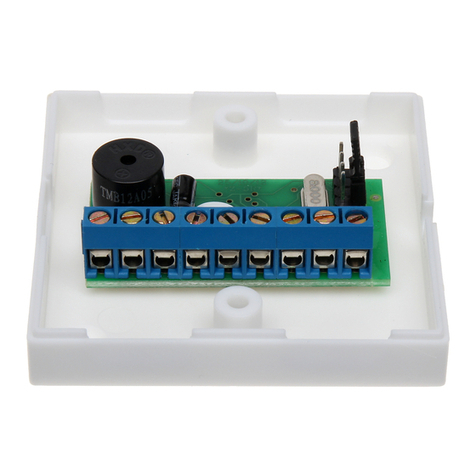
Iron logic
Iron logic Z-5R Relay Wiegand user manual
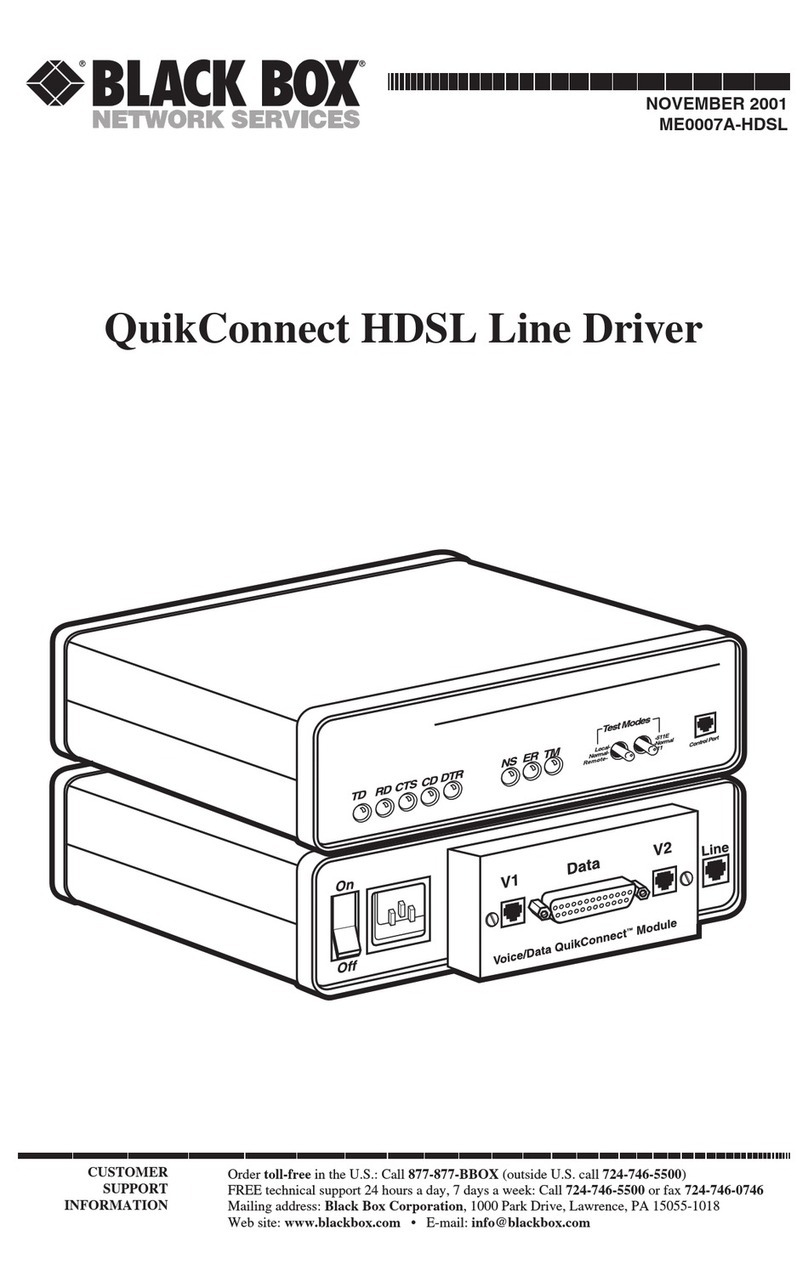
Black Box
Black Box QuikConnect ME0007A-HDSL manual
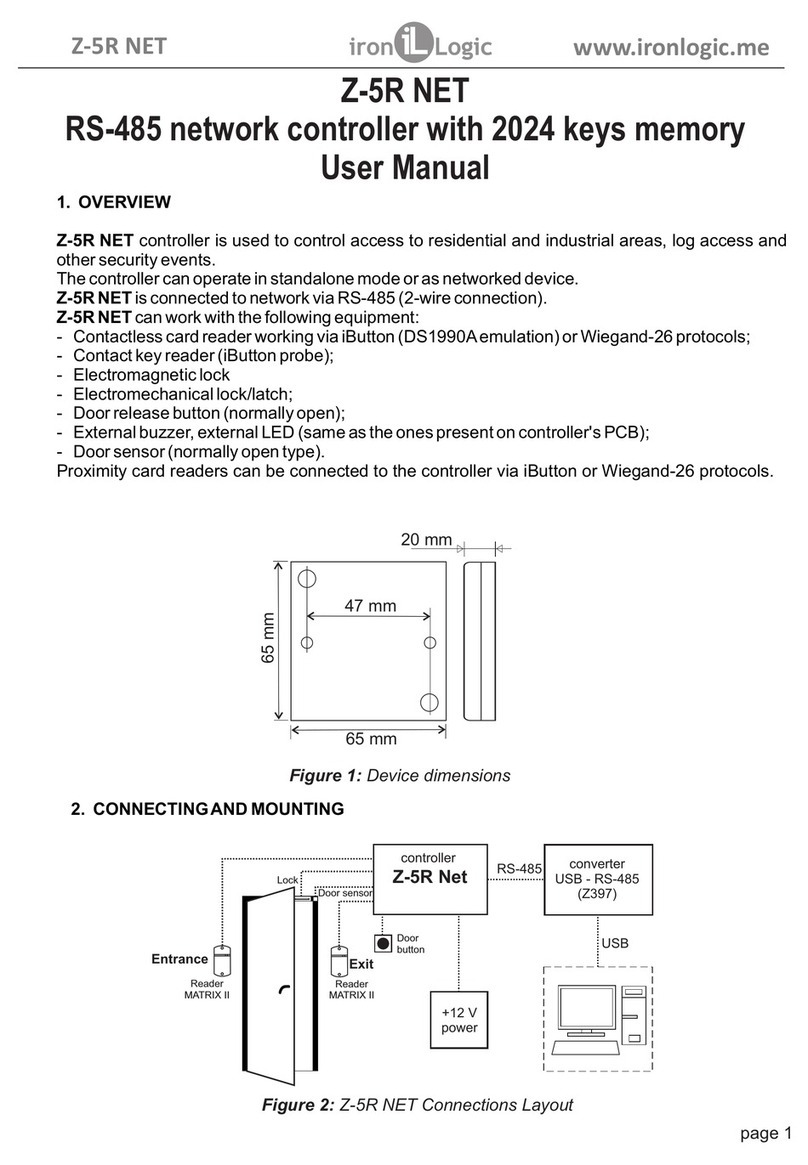
Iron logic
Iron logic Z-5R NET user manual
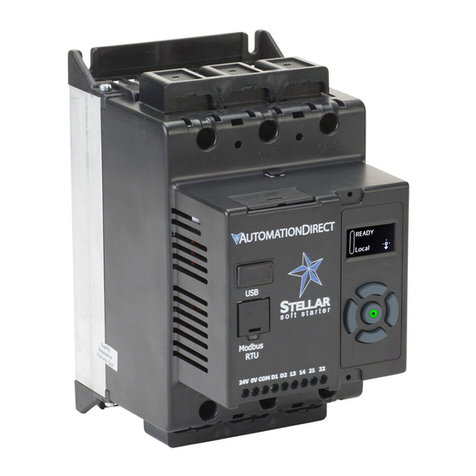
AutomationDirect
AutomationDirect Stellar SR35 Series quick start guide
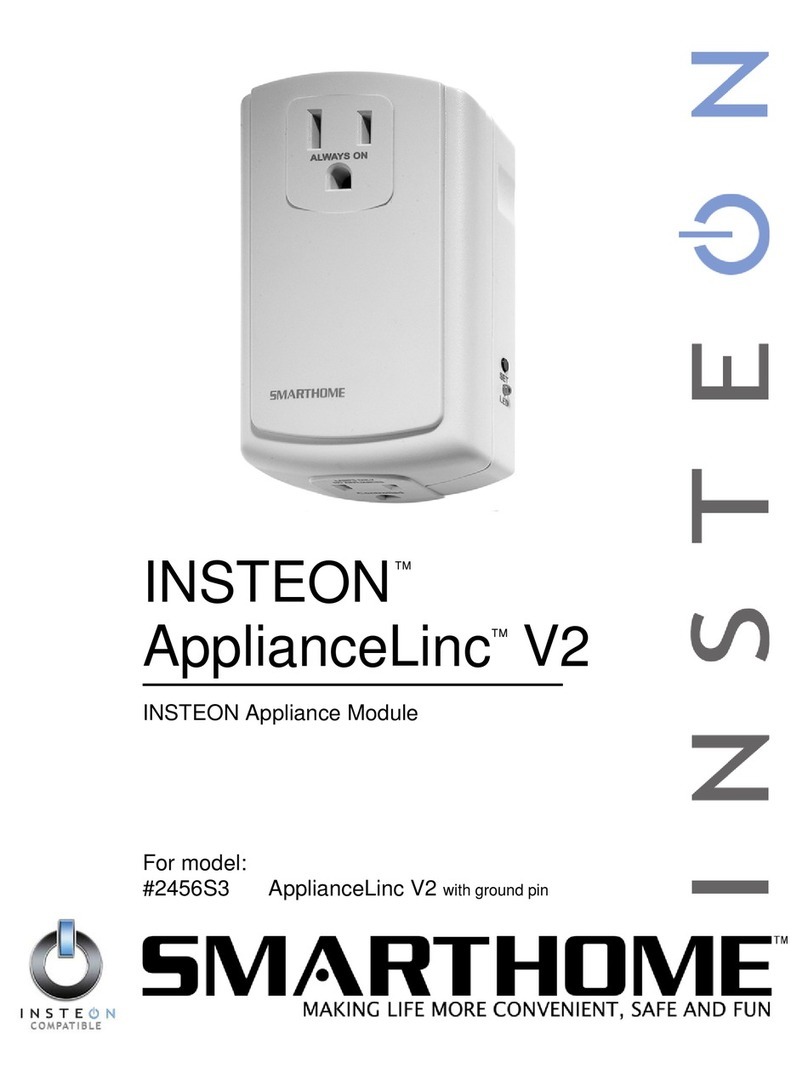
smart home
smart home ApplianceLinc V2 user guide
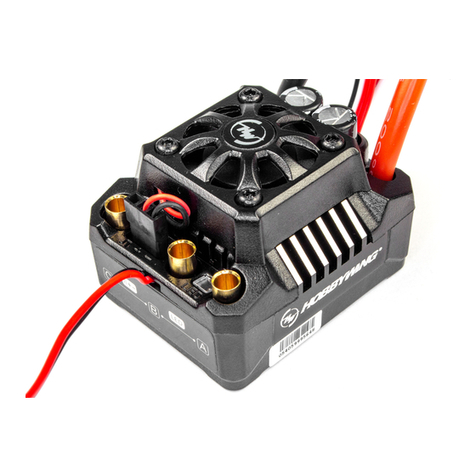
Hobby-Wing
Hobby-Wing EZRUN MAX10 SCT user manual
